Cassava genetic resources
Contact persons for Cassava: Badara Gueye, IITA, Nigeria (in vitro), Soyode Folarin, IITA, Nigeria (field) or Daniel Debouck, CIAT, Colombia
Contributors to this page: CIAT, Colombia (Daniel Debouck); IITA, Nigeria (Dominique Dumet); Bioversity International/ILRI, Ethiopia (Alexandra Jorge); independent consultant (Clair Hershey); INIA, Peru (Llerme Rios).
Compilation of best practices
Information on best practices for genebank management of cassava genetic resources was gathered from current genebank practices and accumulated experience from CIAT and IITA, reviews from the literature and existing websites of major cassava genebanks (EMBRAPA, Brazil; INIA, Peru), as well as valuable information from independent cassava consultants. Crop experts revised and validated this information and these recommendations.
|
|
Cassava genetic resources are considered here to include all the species within the genus Manihot. This review focuses on cultivated cassava (Manihot esculenta) but also references the wild Manihot species in various sections. There are only a few genebanks world-wide that conserve wild Manihot species and the availability of information on best practices for genebank management of these species is still limited.
Importance and origin
Cassava (Manihot esculenta Crantz) is a perennial woody shrub with edible roots, which grows in tropical and subtropical areas of the world. It is also called yuca, manioc and mandioca, along with many other local names. Cassava has the ability to grow on marginal lands, especially in drought-prone conditions and in low fertility, acid soils, where cereals and other crops do not thrive. Because cassava roots can be stored in the ground (while still intact on the growing plant) for up to 24 months or more, harvest may be delayed until market, processing or other conditions are favourable.
The crop has been cultivated in tropical America for probably about 10 000 years. The origin of the species is unknown, but recent taxonomic and molecular evidence suggests a southern Amazon origin (Allem, 1987). It was introduced to Africa by Portuguese traders during the 16th century and later to Asia, both from Africa and from the Americas. It is now grown in over 90 countries and provides food and income for 500 million people in the developing world. It is estimated to be grown on 18.7 million hectares, yielding about 233 million tonnes of roots annually (FAOSTAT 2008).
Genetic resources
Genetic resources of cassava comprise local or introduced landraces, improved cultivars, genetic stocks and related wild species. All known cultivars of cassava belong to the species M. esculenta. According to the latest monograph, the genus Manihot contains 98 species (Rogers and Appan, 1973). The species are concentrated in Meso-America and Brazil, but are distributed widely in the Americas, from the US to Argentina. The genus is morphologically very diverse, containing herbs, shrubs and trees. Only cassava is cultivated. The wild species are mostly seed-propagated and many are very difficult to propagate vegetatively. Most of the species are shade-intolerant and tend to be invaders of forest borders or of open areas where they do not need to compete with other species for sunlight. Many produce storage roots, where starch reserves accumulate to help the plant endure difficult periods, especially drought.
|
|
Utilization
Cassava’s starchy roots are the basis of many food and industrial products. The roots can be eaten in various forms: raw, roasted, boiled, baked, fried, granules, pastes and flour. In many of the cassava-growing countries in Africa, as well as a few other countries of the world, the leaves are also consumed as a green vegetable, which provide protein and vitamins A and B.
All known cultivars produce cyanogenic glucosides in the roots. These glucosides combine with enzymes after cell disruption to release hydrogen cyanide. Only those cultivars with low cyanogenic potential are safe to eat after simple boiling. Many types of processing, such as fermentation, grinding, drying or roasting eliminate most of the cyanide. Through these various types of processing, cultivars of high cyanogenic potential can be rendered safe for human consumption.
The exact evolutionary benefits of high cyanogenic potential are unknown. There are few defined relationships between cyanogenic potential and pest resistance, for example. However, it is known that high potential can deter wild mammals from damaging the crop.
In large areas of subSaharan Africa, and in parts of Latin America and SE Asia, cassava provides a major basic daily source of dietary energy. Once harvested, the cassava roots spoil quickly and must be eaten or processed, typically within three to seven days, to preserve their food or nutritional value. Processing generally involves cooking, grinding, drying or fermenting, or some combination of these, which varies according to local customs. There are now promising results of good genetic variation for post-harvest deterioration and the possibility to improve this trait through breeding.
Cassava is used for human consumption, animal feed and a range of industrial products in Latin America. In Asia cassava has taken on primarily an industrial role. Nonetheless, it is still important as a human food in some Asian countries, especially in Indonesia. Cassava starch is used in a wide range of products: for example, in various food products, in pharmaceuticals, as a binding agent, in the production of paper and textiles and as monosodium glutamate, an important flavouring agent in Asian cooking. In Africa, cassava flour is beginning to be used in partial substitution for wheat flour.
Cassava has long been used as a component of balanced diets for animal feed and may substitute for maize, sorghum or barley depending on the commodity market. Normally a protein source such as soy needs to be added to cassava to obtain nutritional values similar in feed value to the cereal grains. The large cassava industry of Thailand developed out of a niche market for cassava chips and pellets in Europe's animal feed industry in the 1970s. Since the turn of the 21st century, use of cassava to produce ethanol has gained considerable popularity, especially in Asia.
Propagation
Cassava is mostly propagated vegetatively by stem cuttings. Its production is therefore greatly dependent on the supply and quality of these cuttings. The multiplication rate of this vegetative planting material is very low compared to grain crops, which are generally propagated by true seeds. Typically cassava has a multiplication rate on the order of 10:1, although this may vary widely depending on genotype and growing conditions. In addition to the constraint imposed by a low multiplication rate, cassava stem cuttings are bulky, difficult to transport and highly perishable: they may begin to dry out and lose viability within a few days after harvest. Moreover, phytosanitary regulations prohibit the movement of cassava stem cuttings across international borders (to prevent the spread of diseases and insects), so special arrangements have to be made for storage and transportation of germplasm.
Under natural conditions all the wild Manihot species are propagated from seed, although some can be propagated vegetatively under special care.
Networks and organizations
There are a number of networks and organizations that focus on cassava research and development, or include cassava among other commodities. During the 1970s and 1980s, several networks began and functioned for a period of time, but were not sustained mainly due to broad funding cuts for agriculture in the 1990s and 2000s. The remaining active organizations, among those listed below are: ISTRC, Africa Branch of the ISTRC, EARRNET and CLAYUCA.
African Branch of the ISTRC
African Francophone Cassava Network (CORAF)
Asian Cassava Research Network
Cassava R&D workers
Cassava Biotechnology Network
Cassava Genetic Resources Network
Collaborators in Root and Tuber Improvement and Systems (CORTIS)
Eastern and Southern African Root Crop Research Network (EARRNET) (http://www.asareca.org/earrnet/)
International Society for Tropical Root Crops (ISTRC) (http://www.istrc.org/)
Global Cassava Development Strategy (GCDS)
Global Cassava Partnership for Genetic Improvement (GCP-GI)
Latin American Consortium for Cassava (CLAYUCA) (http://www.clayuca.org/)
Latin American Integrated Projects Network
MOLCAS
Panamerican Cassava Breeders Network
Southern Cone Cassava Development Network
References and further reading
Allem AC. 1987. Manihot esculenta is a native of the neotropics. Plant Genetic Resources Newsletter 71:22-24. IBPGR/FAO.
Allem AC. 1994. The origin of Manihot esculenta Crantz (Euphorbiaceae). Genetic Resources and Crop Evolution 41:133-150. The Netherlands.
Allem AC. 2002. The origins and taxonomy of cassava. In: Hillocks RJ, Thresh JM, Bellotti AC, editors. Cassava: Biology, Production and Utilization. CABI, New York. pp. 1-16.
Best R, Henry G. 1994. Cassava: Towards the year 2000. In: International Network for Cassava Genetic Resources. Report of the First Meeting, CIAT, Cali, Colombia, 18-23 August 1992. International Crop Network Series No. 10, IPGRI, Rome, Italy. pp. 3-11.
Carter SE, Fresco LO, Jones PG, Fairbairn JN. 1997. Introduction and diffusion of cassava in Africa, IITA Research Guide 49.
Available from: http://old.iita.org/cms/details/trn_mat/irg49/irg49.html. Date accessed: 11 August 2010.
Ceballos H. 2006. Cassava research at CIAT [poster]. Centro Internacional de Agricultura Tropical (CIAT), Cali, Colombia. Available from: http://webapp.ciat.cgiar.org/news/pdf/poster02_scmeeting_06.pdf. Date accessed: 26 August 2010.
CIAT. 1984. Cassava Program Annual Report. Centro Internacional de Agricultura Tropical (CIAT), Cali, Colombia.
CIAT. 1993. Cassava Program Annual Report. Centro Internacional de Agricultura Tropical (CIAT), Cali, Colombia.
Devries J, Toenniessen G. 2001. Securing the harvest: biotechnology, breeding and seed systems for African crops. CABI Publishing, New York. 208 pp.
FAO/IFAD. 2000. The world cassava economy: facts, trends and outlook. FAO/IFAD. Rome. Available from www.fao.org/docrep/009/x4007e/x4007e00.htm. Date accessed: 25 March 2010.
FAOSTAT. 2008. Statistical database of the Food and Agriculture Organization of the United Nations FAOSTAT. Available from: http://faostat.fao.org. Date accessed: 10 August 2010.
Fresco L. 1986. Cassava in shifting cultivation: a systems approach to agricultural technology development in Africa. Royal Tropical Institute, Amsterdam. 290 pp.
Hahn SK, L Reynolds, GN Egbunike. 1992. Cassava as livestock feed in Africa: proceedings of the IITA/ILCA/University of IBADAN workshop on the potential utilization of cassava as livestock feed in Africa. 14-18 November, 1988. IITA. Ibadan, Nigeria. Available from: www.fao.org/Wairdocs/ILRI/x5458E/x5458E00.htm. Date accessed: 25 March 2010.
Hillocks RJ, Thresh JM, Bellott AC, editors. 2002. Cassava: biology, production and utilization. CABI International, NY. 332 pp.
Howeler RH, Oates CG, Allem AC. 2001. Strategic environmental assessment: an assessment of the impact of cassava production and processing on the environment and biodiversity. Proceedings of the Validation Forum on the Global Cassava Development Strategy, Rome, 26-28 April 2000. FAO and IFAD, Rome.
IITA. 1993. Annual Report. International Institute for Tropical Agriculture. Ibadan, Nigeria. 64 pp.
IPGRI. 1994. Report of the First meeting of the International Network for Cassava Genetic Resources, CIAT, Cali, Colombia, 18-23 August 1992. International Crop Network Series No. 10. International Plant Genetic Resources Institute, Rome, Italy. 179 pp.
Lozano JC, Byrne D, Bellotti A. 1980. Cassava/ecosystem relationships and their influence on breeding strategy. Tropical Pest Management. 26:180-187.
Machin D, Nyvold S, editors. 1992. Roots, tubers, plantains and bananas in animal feeding. In: Proceedings of the FAO expert consultation held in CIAT, Cali, Colombia. 21-25 January 1991. FAO. Rome. Available from: www.fao.org/DOCREP/003/T0554E/T0554E00.HTM. Date accessed: 25 March 2010.
Nweke FI, Spencer DSC, Lynam JK. 2002. The cassava transformation: Africa’s best-kept secret. Michigan State University Press, East Lansing, MI.
Olsen KM. 2004. SNPs, SSRs and inferences on cassava’s origin. Plant Molelucar Biology 56:517-526.
Ospina B, Ceballos H, editors. 2002. La yuca en el tercer milenio: sistemas modernos de producción, procesamiento, utilización y comercialización [Cassava in the third milenium: modern systems of production, processing, utilization and commercialization]. CIAT Publication No. 327, CIAT, Cali, Colombia.
Phillips T, Taylor D, Sanni L, Akoroda M. 2004. A cassava industrial revolution in Nigeria: the potential for a new industrial crop. IFAD, FAO, Rome. Available from: www.fao.org/docrep/007/y5548e/y5548e00.htm. Date accessed: 25 March 2010.
Purseglove JW. 1968. Tropical crops: dicotyledons. Longman, London.
Roa AC, Maya MM, Duque MC, Tohme J, Allem AC, Bonierbale MW. 1997. AFLP analysis of relationships among cassava and other Manihot species. Theoretical and Applied Genetics 95:741-750.
Rogers DJ, Appan SG. 1973. Manihot, Manihotoides (Euphorbiaceae), Flora Neotropica, Monograph no. 13. Hafner Press, New York. 272 pp.
Tewe OO. 2004. Cassava for livestock feed in sub-Saharan Africa. FAO/IFAD, Rome. Available from: www.fao.org/docrep/007/j1255e/j1255e00.htm. Date accessed: 25 March 2010.
Comments (2)
-
Guest - toekidjo
I would like to research and study on cassava breeding, started from characterization of locan clones in my place. there so many kind of cultivar or clones planted by farmer so I called as "in situ-on farm genetics of cassava conservation". Hopefully I would get the best local clones/verieties to develop in the future. Would you like to give me suggestion. thanks. toekidjo, Agriculture Faculty GMU Yogyakarta, Indonesia
0 Like -
Guest - CGKB team
Dear Toekidjo,
Please contact one of the contact persons that you can find on top of this page for advice.
Good luck!
The CGKB team0 Like



 Cassava
Cassava
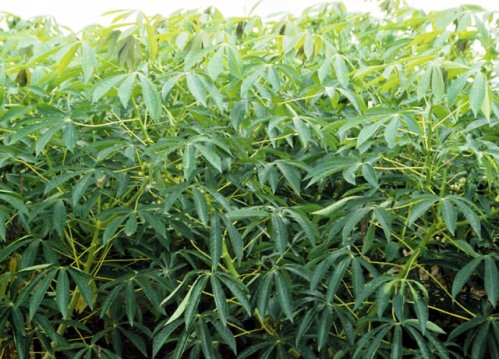
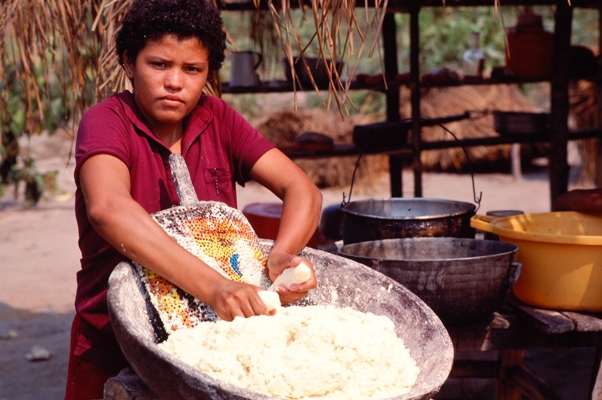
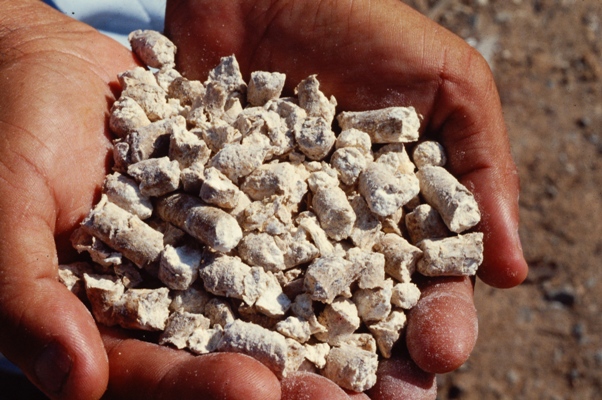
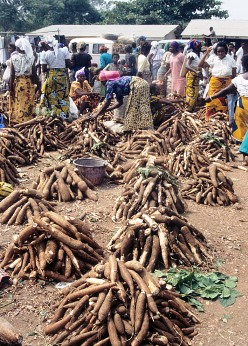
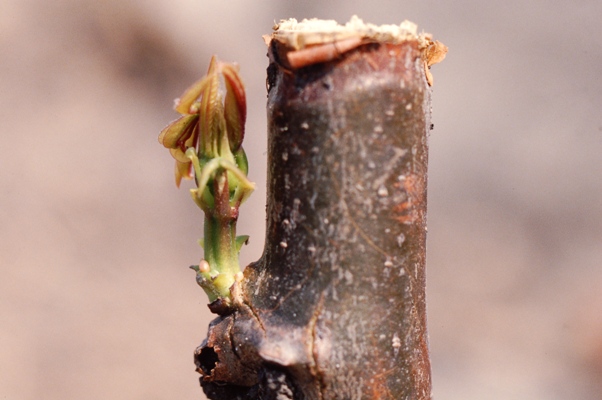
Leave your comments
Post comment as a guest